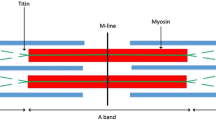Summary
Morphological (Figs. 3–5) and physiological (Fig. 2) data from several crustacean species kept at 19–21 °C show that isolated stumps of motor axons often survive intact for 150–250 days whereas sensory axonal segments usually degenerate within 20 days. Axonal segments of both motor and sensory axons that remain connected to their cell body generally remain functionally and morphologically normal after lesioning. No evidence was found for collateral innervation of denervated muscles from intact motor neurons supplying nearby muscle masses, although the motor nerve terminals may not have completely degenerated. Evidence is presented that motor axons specifically re-innervate their original muscle mass if such re-innervation occurs within 90 days after lesioning. Regenerating sensory and motor fibers make appropriate CNS and peripheral connections so as to re-establish correctly a peripheral reflex (Fig. 2C) found in intact animals (Wilson and Davis, 1965).
Similar content being viewed by others
References
Barker, D. L., Herbert, E., Hildebrand, J. G., Kravitz, E. A.: Acetylcholine and lobster sensory neurones. J. Physiol. (Lond.)226, 205–229 (1972)
Bernstein, J. J., Guth, L.: Nonselectivity in establishment of neuromuscular connections following nerve regeneration in the rat. Exp. Neurol.4, 262–275 (1961)
Birks, R., Katz, B., Miledi, R.: Physiological and structural changes at the amphibian myoneural junction in the course of nerve degeneration. J. Physiol. (Lond.)150, 145–168 (1960)
Bittner, G. D.: The differentiation of crayfish muscle fibers during development. J. exp. Zool167, 439–456 (1968)
Bittner, G. D.: Degeneration and regeneration in crustacean neuromuscular systems. Amer. Zool.13, 379–408 (1973)
Bittner, G. D., Kennedy, D.: Quantitative aspects of transmitter release. J. Cell Biol.47, 585–592 (1970)
Bodenstein, D.: Studies on nerve regeneration inPeriplaneta americana. J. exp. Zool.136, 89–115 (1957)
Edds, M. B., Jr.: Collateral nerve regeneration. Quart. Rev. Biol.28, 260–276 (1953)
Edwards, J. S., Palka, J.: Neural regeneration: Delayed formation of central contacts by insect sensory cells. Science172, 591–594 (1971)
Edwards, J. S., Sahota, T. S.: Regeneration of a sensory system: the formation of central connections by normal and transplanted cerci of house cricket,Acheta domesticus. J. exp. Zool.166, 387–395 (1968)
Gaze, R. M.: The formation of nerve connections. New York: Academic Press 1970
Grimm, L.: An evaluation of myotypic respecification in axolotls. J. exp. Zool.17 479–496 (1971)
Guthrie, D. M.: Regenerative growth in insect nerve axons. J. Insect Physiol.8, 79–92 (1962)
Guthrie, D. M.: Physiological competition between host and implanted ganglia in an insect (Periplaneta americana). Nature (Lond.)210, 312–313 (1964)
Guthrie, D. M.: The regeneration of motor axons in an insect. J. Insect Physiol.13, 1593–1611 (1967)
Hoy, R. R.: Degeneration and regeneration in abdominal flexor motor neurons in the crayfish. J. exp. Zool.172, 219–323 (1969)
Hoy, R. R., Bittner, G. D., Kennedy, D.: Regeneration in crustacean motoneurons: evidence for axonal refusion. Science156, 251–252 (1967)
Jacklet, J. W., Cohen, M. J.: Nerve regeneration: correlation of electrical, histological and behavioral events. Science156, 1640–1643 (1967)
Jacobson, S., Guth, L.: An electrophysiological study of the early stages of peripheral nerve regeneration. Exp. Neurol.11, 48–60 (1965)
Mark, R. F.: Fin movement after regeneration of neuromuscular connections: an investigation of myotypic specificity. Exp. Neurol.12, 292–302 (1965)
Nordlander, R. H., Singer, M.: Electron microscopy of severed motor fibers in the crayfish. Z. Zellforsch.126, 157–181 (1972)
Nordlander, R. H., Singer, M.: Effects of temperature on the ultrastructure of severed crayfish motor axons. J. exp. Zool.184, 289–302 (1973)
Ohmi, S.: Electronmicroscopic study on Wallerian degeneration of the peripheral nerve. Z. Zellforsch.54, 39–67 (1961)
Pearson, K. G., Bradley, A. B.: Specific regeneration of excitatory motorneurones to leg muscles in the cockroach. Brain Res.47, 492–496 (1972)
Ramon y Cajal, S.: Degeneration and regeneration of the nervous system. (Transl. by R. M. Macy.) London: Univ. Press 1928
Ranson, S. W.: Degeneration and regeneration of nerve fibers. J. comp. Neurol.22, 487–537 (1942)
Rees, D., Usherwood, P. N. R.: Fine structure of normal and degenerating motor axons and nerve-muscle synapses in the locust,Schistocerca gregaria. Comp. Bioehem. Physiol.43, 83–101 (1972)
Sperry, R., Aurora, H. L.: Selectivity in regeneration of the oculomotor nerve in the chichlid fish,Astronotus ocellatus. J. Embryol. exp. Morph.14, 307–319 (1965)
Usherwood, P. N. R.: Response of insect muscle to denervation. II. Changes in neuromuscular transmission. J. Insect Physiol.9, 811–825 (1963)
Usherwood, P. N. R., Cochrane, D. G., Rees, D.: Changes in insect excitatory nerve-muscle synapses after motor nerve section. Nature (Lond.)218, 589–591 (1968)
Weiss, P., Hoag, A.: Competitive reinnervation of rat muscles by their own and foreign nerves. J. Neurophysiol.9, 413–418 (1946)
Wilson, D. M., Davis, W. J.: Nerve impulse patterns and reflex control in the motor system of the crayfish claw. J. exp. Biol.43, 193–210 (1965)
Wine, J. J.: Invertebrate central neurons: Orthograde degeneration and retrograde changes after axonotomy. Exp. Neurol.38, 157–169 (1973)
Young, D.: Specific re-innervation of limbs transplanted between segments in the cockroach. J. exp. Biol.57, 305–316 (1972)
Young, J. Z.: The functional repair of nervous tissue. Physiol. Rev.22, 318–373 (1942)
Author information
Authors and Affiliations
Additional information
We would like to thank Ms. Frances Eggleston and Mr. Glen Buckspan for their assistance in carrying out these experiments and Mr. Milton Charlton for his careful reading of this manuscript. This work was supported in part by grants from NTH (#26-167-3550) and NSF (GB-30199).
Rights and permissions
About this article
Cite this article
Bittner, G.D., Johnson, A.L. Degeneration and regeneration in crustacean peripheral nerves. J. Comp. Physiol. 89, 1–21 (1974). https://doi.org/10.1007/BF00696159
Received:
Issue Date:
DOI: https://doi.org/10.1007/BF00696159




